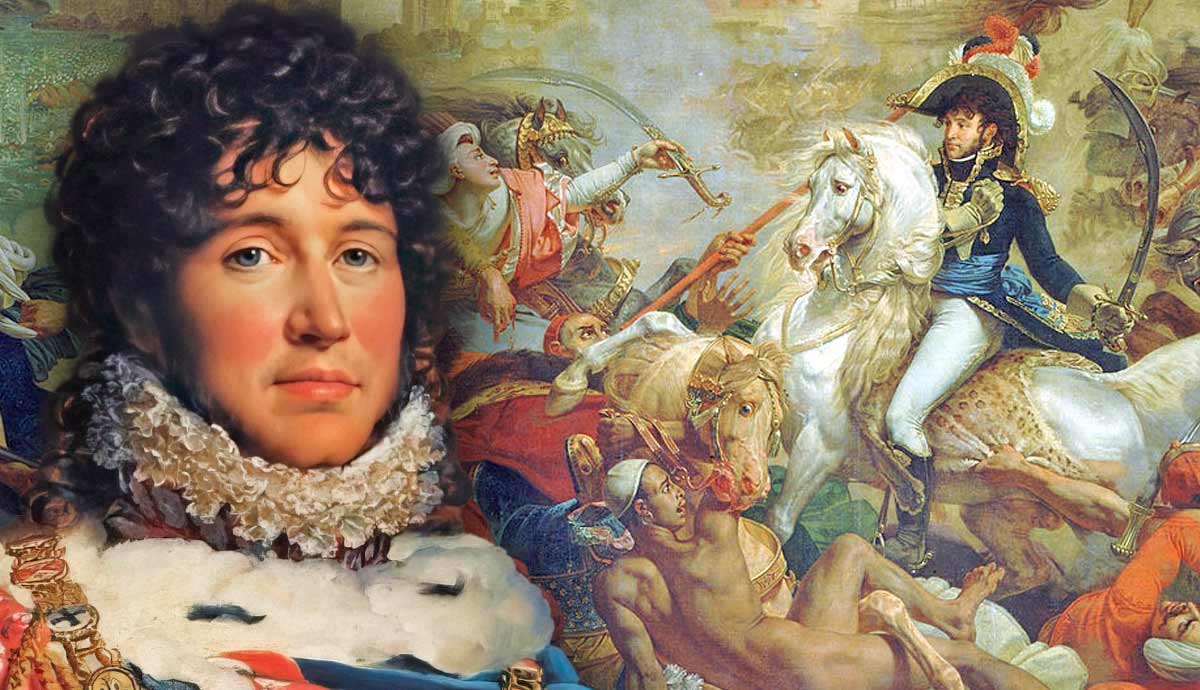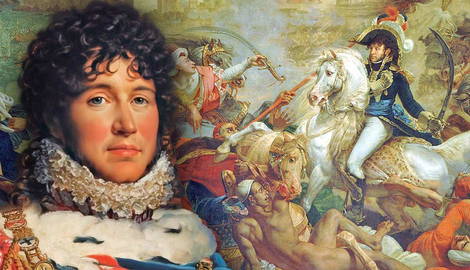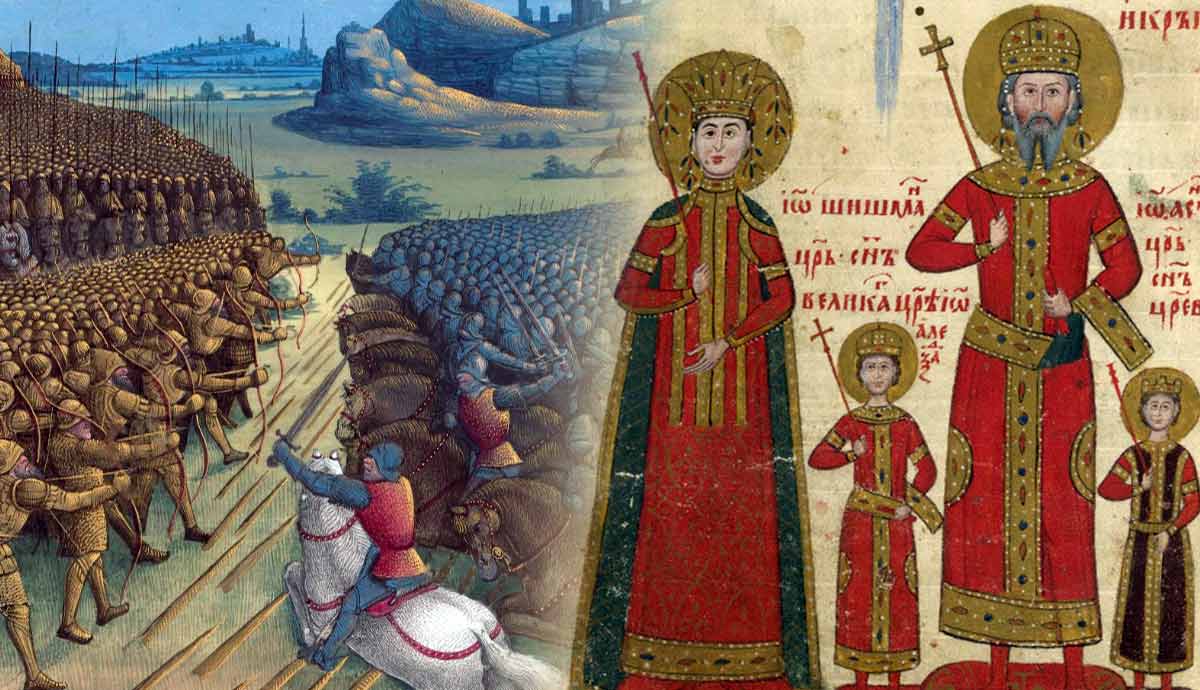
The son of an innkeeper, Joachim Murat, was a dashing cavalryman who served with General Napoleon Bonaparte in Italy and Egypt. In 1800, he married Bonaparte’s youngest sister, Caroline, and was named marshal in 1804. After commanding Napoleon’s cavalry with distinction in the campaigns of 1805-07, he became King of Naples in 1808. After fighting in the 1812 campaign in Russia and the campaigns of 1813 in Germany, he switched sides to keep his crown, only to rally to Napoleon again in 1815, a decision that would cost him his life.
Joachim Murat & Napoleon at the Battle of Eylau

On the morning of February 8, 1807, Emperor Napoleon’s Grande Armée confronted Russian general Levin August Bennigsen’s army near Eylau in East Prussia. A heavy snowstorm hindered visibility across the field, and as Marshal Pierre Augereau’s VII Corps advanced in the center, they lost their way and were cut down at short range by murderous artillery fire. As they withdrew, they were pursued relentlessly by Russian cavalry, leaving a huge gap in the French lines.
With the whole French line engaged, Napoleon searched for fresh reserves to meet the Russian threat. Apart from his precious Imperial Guard, Marshal Murat’s 11,000-strong reserve cavalry stood in wait. The emperor ordered Murat to charge against the Russian cavalry pursuing Augereau.
Partly concealed by the weather, Murat led a charge that scattered the Russian cavalry while General Jean-Joseph d’Hautpoul’s heavy cavalry broke through two lines of Russian infantry until beaten back by reserves. Fresh waves of French cavalry crashed through the Russian lines once again. Now behind enemy lines, Murat’s troopers reformed and charged back through the Russian infantry.
Over 1,000 French cavalrymen fell in the charge, and General d’Hautpoul was mortally wounded, but with a single stroke, Murat had changed the course of the battle. While Murat’s intervention was not enough to win the battle, which ended in a bloody stalemate, it prevented Napoleon from suffering a significant defeat. Napoleon managed to win a decisive victory at Friedland in June, enabling him to make peace with Russia on his terms.
The Young Hussar

Joachim Murat was born in March 1767 in La Bastide-Fortunière in southern France, where his father served as a postmaster and innkeeper. Murat began to train as a priest but left the seminary on the eve of his 20th birthday after supposedly fighting a duel over a girl. He soon enlisted in the French army and joined a cavalry regiment.
Following the French Revolution in 1789, Murat helped to organize the local National Guard. By early 1792, he was serving in King Louis XVI’s Constitutional Guard, though it lasted less than a month before a disciplinary issue prompted him to leave. He rejoined his old regiment, now renamed the 12th Horse Chasseurs, and became a lieutenant by the end of the year.
Murat’s regiment was sent to General Dumouriez’s army in Flanders, but after a series of defeats, the French commander defected to the Austrians. In 1793, Murat was transferred to command a squadron in the 21st Horse Chasseurs but was soon suspected of being related to the noble family Murat d’Auvergne during the height of Robespierre’s terror. He proved his innocence and rejoined his regiment in Paris.
In October 1795, a Royalist mob in Paris rebelled against the revolutionary government. Twenty-six-year-old General Napoleon Bonaparte organized the defense of the capital and ordered Colonel Murat to bring some artillery from the outskirts of Paris. The guns were duly set up in position, and the Royalists were scattered by Bonaparte’s “whiff of grapeshot.”
Bonaparte’s Cavalry Commander

After his successful defense of Paris, Bonaparte joined the Army of Italy and became overall commander in the spring of 1796. Murat joined Bonaparte’s staff and led his first cavalry charge at the Battle of Dego against Piedmontese troops in April. During the campaign, he demonstrated his effectiveness as a commander of combined arms units, and in May he was promoted to general of brigade.
In 1798, Murat joined Bonaparte’s campaign in Egypt as cavalry commander, though he played little part in the Battle of the Pyramids in August, during which the Egyptian Mamluk cavalry was largely defeated by French infantry squares and artillery fire.
Although Bonaparte quickly occupied Cairo and established a government in Egypt, the French navy was defeated by British admiral Horatio Nelson at the Battle of the Nile at the beginning of August, cutting off communications with France. Napoleon fought the Ottoman Turks in Syria and Palestine but abandoned his attempt to capture the port of Acre in May 1799 after a two-month siege and returned to Egypt.
In late July, Napoleon confronted an 18,000-strong Ottoman force under Mustapha Pasha that had landed at Aboukir Bay. Murat commanded the vanguard and led a devastating charge through a gap in the enemy center. After driving the Ottomans into the sea, Murat rode into enemy headquarters and demanded surrender from Mustapha Pasha. When the enemy commander refused and shot him in the jaw, Murat slashed at his assailant with his saber and cut off two fingers. His exploits at the Battle of Aboukir won him promotion to general of division.
Imperial Prince

The victory at Aboukir restored some pride in Bonaparte’s army, and Murat was part of the small entourage that joined Napoleon when he slipped back to France in August. When Bonaparte took power as First Consul of the French Republic in November 1799, Murat led the Grenadiers in dispersing the Council of the Five Hundred while they attempted to resist the coup.
Napoleon rewarded Murat with the command of the Consular Guard. Not long afterward, the 33-year-old Murat strengthened his ties to the Bonaparte family by marrying the 17-year-old Caroline Bonaparte, the First Consul’s youngest sister.
In May 1804, following his proclamation as Emperor of the French, Napoleon named eighteen generals Marshal of the Empire, with Murat’s name second on the list. As the emperor’s brother-in-law, Murat was later given the titles of imperial prince and Grand Admiral of the Empire.
In August 1805, after abandoning his plans to invade England, Napoleon turned his attention to the Austrians advancing from the east. Murat served as vanguard commander in a lightning operation that resulted in the encirclement and surrender of General Mack’s Austrians at the Bavarian city of Ulm. He then spearheaded the pursuit of Russian general Mikhail Kutuzov down the Danube. At Napoleon’s great victory at the Battle of Austerlitz on December 2, Murat commanded the French left and helped Marshal Jean Lannes drive Russian general Prince Bagration’s column away from the battlefield.
Prussia & Poland

The defeat of the Austrians in 1805 enabled Napoleon to increase his influence in western Germany, and in March 1806, he made Murat Grand Duke of Berg and Cleves in the Rhineland. Napoleon’s German policy prompted the Kingdom of Prussia to take up arms against him, but on October 14, his forces crushed two Prussian armies at Jena and Auerstedt in Saxony.
Murat’s cavalry played a prominent role in the Battle of Jena, but his relentless pursuit of the retreating Prussians over the coming weeks held greater strategic importance in preventing the Prussians from reforming. Murat’s subordinate, General Antoine Lasalle, achieved particular distinction in forcing the surrender of the Prussian garrison at Stettin at the head of 500 cavalry. In November, Murat entered Warsaw and was greeted as a liberator by the local Polish population.
Following the bloody encounter at Eylau, both the French and Russian armies spent the next few months restoring their manpower. When active campaigning recommenced in June, Napoleon advanced against Bennigsen’s position at Heilsberg and attacked on June 10. As vanguard commander, Murat led a disastrous cavalry charge against the Russian position and was almost taken prisoner. Four days later, Napoleon defeated the Russians decisively at the Battle of Friedland, but Murat was too far from the field to play a part.
Spain & Naples

After the victory at Friedland, Napoleon signed a peace treaty with Alexander I of Russia in July 1807, which compelled Russia to join the Continental System, Napoleon’s scheme to weaken the British economy by blocking British ships from continental trade. In late 1807, Napoleon sought to bring Portugal into the Continental System by sending an invasion force through Spain under General Jean-Andoche Junot.
Although Spain was France’s ally, by early 1808, the country found itself in a political crisis, with both Carlos III and his son Fernando VII claiming the throne. Napoleon offered to mediate, but to many Spaniards, the country was effectively under French military occupation. Murat’s appointment as lieutenant-general of Spain sparked an uprising in Madrid on May 2, which was brutally put down by Murat’s troops.
In July, Napoleon adopted Murat’s suggestion of addressing the political crisis by inviting the two rival monarchs to a conference just over the border in France before deposing them both and placing his brother Joseph on the Spanish throne. Murat succeeded Joseph as King of Naples. Although he enjoyed displaying himself ostentatiously as a king, he was often frustrated by Napoleon’s incessant demands for money and troops. Queen Caroline often encouraged her husband to act more independently and defy her brother’s demands.
The Russian Campaign

After three years of ruling Naples, Murat joined Napoleon’s invasion of Russia in 1812. As the Russian armies retreated towards Moscow, he often found himself leading charges against determined Russian rearguards covering the withdrawal of their comrades. At the Battle of Borodino on September 7, Murat found himself in the thick of the fighting, and it was his cavalry that captured the Great Redoubt. In the late afternoon, Murat’s troopers were engaged in a fierce duel with fresh Russian cavalry and were eventually compelled to retire.
A week later, on September 14, Murat’s vanguard was the first into Moscow. General Mikhail Miloradovich, the Russian rearguard commander, offered Murat a 24-hour truce, promising him that peace would soon be made. Murat agreed, giving the Russian army precious time to perform an orderly retreat. A furious Napoleon ordered Murat to continue the pursuit, but the French lost track of the Russian army for three days.
Murat eventually found the Russian camp at Tarutino and made his own camp a short distance away. In anticipation of a peace agreement, Murat invited Miloradovich to his headquarters. However, the war was not yet over, and on October 18, the Russians launched a surprise attack on Murat’s camp and inflicted heavy losses. Upon hearing this, Napoleon made preparations to leave Moscow. After leading around 30,000 men across the Berezina in late November, the emperor hurried to Paris a week later, leaving Murat in charge.
A Ridge Too Far

Murat was also keen to return to Naples following the Russian debacle, and after leaving Russian territory, he gave command to Prince Eugène de Beauharnais, Viceroy of Italy and Napoleon’s stepson. As Napoleon desperately tried to rebuild the army lost in Russia, Murat began talks with the Sixth Coalition that was forming against Napoleon in an effort to keep his throne.
Napoleon returned to the field in May 1813 and defeated the Russians and Prussians at Lutzen and Bautzen, but the inability to replace the horses he lost in Russia hindered his cavalry’s ability to pursue the enemy. With the death of his cavalry commander Marshal Jean-Baptiste Bessières on the eve of Lutzen, Napoleon appealed to Murat to join him.
The King of Naples answered the call in August and distinguished himself during Napoleon’s victory against the odds at the Battle of Dresden in late August. However, the Sixth Coalition armies recovered from the defeat and were encroaching on Napoleon’s army at Leipzig in mid-November. On October 16, the first day of the Battle of Leipzig, Napoleon launched a sustained attack on the allied position to the south of the city. After sustained artillery fire opened a hole in the enemy lines, Murat led a grand cavalry charge that reached the foot of the hill of the allied command post from where the sovereigns of Austria, Prussia, and Russia were observing the battle. However, Murat’s unwieldy columns were swarmed by more agile allied cavalry formations and forced to fall back to their own lines.
Double Treachery

After Leipzig, Napoleon decided to give up his claims in Germany and focus on the defense of France. Sensing that the emperor might also abandon Naples, Murat signed an agreement with Austria to switch sides. In January 1814, King Joachim led an army of 30,000 men and advanced against Prince Eugène in northern Italy while the main allied armies invaded France from the east. On April 15, Murat received news of Napoleon’s abdication and exile to the island of Elba off Tuscany.
In October, when the allies met at the Congress of Vienna to determine the future of Europe, the fate of Naples was a key item on the agenda. Although Austrian foreign minister Count Metternich hoped to abide by his agreement with Murat, the British, Russian, and French representatives supported the restoration of King Ferdinand IV of Naples.
In February 1815, Napoleon escaped from Elba and landed in southern France. After losing trust in the Congress of Vienna, Murat preemptively attacked the Austrians in northern Italy and issued a proclamation of Italian unity. Despite initial successes, defeat at the Battle of Tolentino on May 3rd sealed his fate.
Murat abandoned Naples and sailed to France, pledging his loyalty to Napoleon, but the emperor refused to receive him. He remained at Toulon until Napoleon’s defeat at the Battle of Waterloo on June 18 and escaped to Corsica. He resolved to retake Naples but landed in the small fishing port of Pizzo with only 30 men. He was arrested by the local authorities and executed before a firing squad on October 13, 1815.










